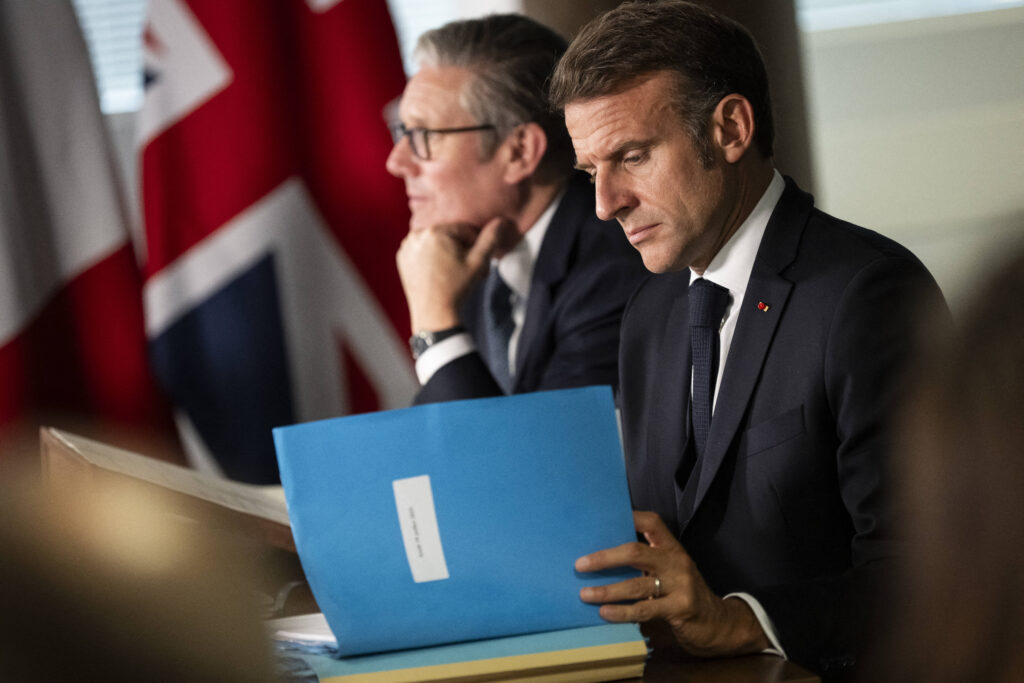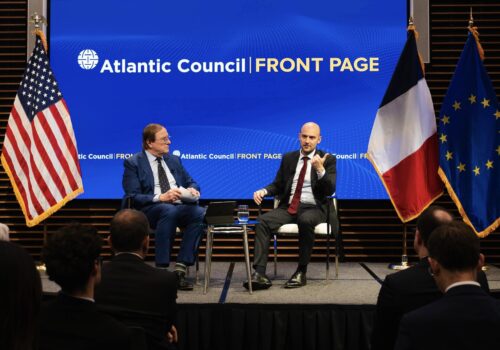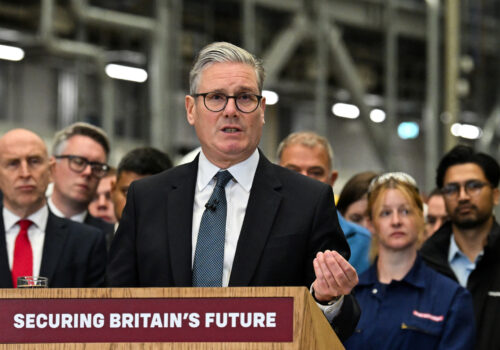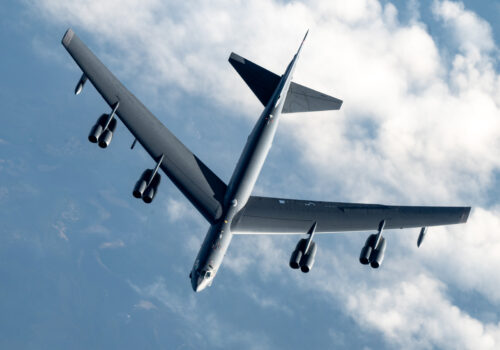For the first time in more than a decade, France and the United Kingdom have issued a joint nuclear statement. The Northwood Declaration takes its name from the British military headquarters northwest of London where French President Emmanuel Macron and British Prime Minister Keir Starmer announced it on July 10. At that event, Starmer called the declaration “truly historic,” and it very much has the potential to be. But understanding why requires parsing what’s in the document and what it could mean for French and British nuclear cooperation.
To begin with, the declaration comes amid a larger debate on nuclear deterrence in Europe that has emerged in the wake of Russia’s full-scale war in Ukraine, including its nuclear dimension. At the same time, many voices in Washington are calling for a strategy of “burden shifting” to allies to respond to a “two nuclear peer” environment, thereby setting the conditions to potentially remove more US conventional military assets from Europe.
At last month’s NATO Summit in The Hague, the United States reiterated its commitment to Article 5’s collective defense and US extended deterrence pledge to allies, but it did so on the underlying condition that Europeans take on more of the burden for the deterrence and defense of the continent. While many of those challenges lie in the conventional domain, Europe will also need to play a role to reinforce the overall security of the Alliance and the continent to complement the United States’ extended deterrence for Europe. As the two nuclear-weapon states of Europe, the United Kingdom and France will naturally lead any evolution in this realm. The Northwood Declaration marks an important step forward in that leadership.
What’s new in the France-UK nuclear declaration?
Since the 1995 Chequers Declaration, the United Kingdom and France have agreed that they do not envisage “situations arising in which the vital interests of either” nation “could be threatened without the vital interest of the other also being threatened.” A major new element of the Northwood Declaration is an acknowledgement that there is “no extreme threat to Europe that would not prompt a response by our two nations.” In other words, the statement is about a common response to a crisis scenario that would bear an extreme threat to the continent, not just to the two nations. While the exact nature of the response is not stated, the document elsewhere notes that “nuclear weapons exist to deter the most extreme threats.” In practice, this could mean that, from now on, both countries will anticipate crises and response scenarios in which both nuclear arsenals are involved together. France and Britain could maximize their nuclear forces’ strategic effects by, for example, envisaging and planning for joint responses, including potentially targeting an adversary.
Next, the new declaration states that “nuclear forces are independent, but can be coordinated,” an entirely new wording with some potentially important consequences.
Deterrence is a permanent posture, whereby a potential adversary must be convinced that use is always a possibility. To establish this certitude, both countries rely on different doctrines, systems, and policies. Most relevant here is the divergence between the United Kingdom and France on the notion of their deterrents’ independence, and relatedly, how they view coordination with other nuclear-armed allies.
It is a cornerstone of France’s nuclear policy that its arsenal “guarantees independence, freedom of appreciation, decision and action.” In practice, this means that France masters nearly all the technical elements of the oceanic and air-based components of its deterrent force and remains outside of NATO’s nuclear planning. But its deterrent is nonetheless “contributing to the overall strengthening of the deterrence of the Alliance.”
Conversely, the United Kingdom, while retaining full operational control over its use, relies on extensive technical cooperation with the United States on multiple aspects of its oceanic nuclear force, especially the acquisition of submarine-launched ballistic missiles. Since 1962, London has committed its forces to NATO nuclear planning as “membership [to the Alliance] sits at the heart of UK policy.” During the latest NATO Summit, the United Kingdom joined NATO’s dual-capable aircraft nuclear mission, which further anchored London’s nuclear policy within NATO.
In the new declaration, France and the United Kingdom have agreed to potentially coordinate their permanent nuclear postures. Importantly, this does not mean that they will relinquish the sovereignty of their nuclear decision-making. In practice, one of the first areas of coordination could be nuclear-powered ballistic-missile submarine (SSBN) patrols. Since both countries have a policy of continuous at-sea deterrence, Paris and London could do a lot more together, starting with sharing intelligence, as well as signaling by, for example, coordinating port calls. They could also assign conventional assets to assist each other, such as protecting the SSBNs before the submarine becomes untraceable in the ocean’s depths or tracking Russian anti-submarine warfare assets.
Furthermore, the United Kingdom could participate in French air-based nuclear exercises. British forces could, for instance, participate in the French strategic air force’s “Poker” quarterly exercises, which simulate a large-scale mission of the air leg of the French nuclear dyad, by providing escort or tanker aircraft. Italy has already assigned conventional means to a “Poker” exercise, by contributing a tanker aircraft in 2022. With the Royal Air Force decision to return to a nuclear mission, even more options could be considered at a later stage.
The overall effect of the Northwood Declaration is that it brings the United Kingdom and France closer to one another. Paris is expanding the European dimension of its vital interests, stating that its arsenal can be “coordinated and contribute significantly to the overall security of the Alliance.” This builds on France’s long-standing policy that its vital interests extend beyond its national borders: “Since 1964, [the French nuclear deterrent] has played a clear role in the preservation of peace and security in Europe,” as Macron said in a national address in March. For its part, London is reinforcing the European dimension of its deterrent, as the declaration states that British nuclear forces protect against “extreme threats to Europe.” This is a much stronger statement than the bilateral 2009 joint statement, which said that British “nuclear forces contribute to European security as a whole.”
Finally, the declaration states that both countries will create a Nuclear Steering Group to “coordinate across nuclear policy, capabilities and operations.” Led by the presidency of the French Republic and the UK Cabinet Office, the dialogue will facilitate the implementation of the Northwood Declaration. Since 1992, a Joint Nuclear Commission on policies and doctrines has convened regularly at the political level to discuss areas of mutual interests, shared perspectives, and strategies on competitors. This Commission comes on top of military-to-military staff talks. But this newly announced steering group marks an important upgrade. It is likely, for example, to include cooperation on technical aspects, pursuing the existing cooperation dating back to the 2010 Lancaster House Treaty. At the Epure facility in France, both countries conduct tests to underwrite the reliability and safety of their nuclear warheads. On a political as much as on a technical level, increased site visits and exchanges could signal the depth of the new nuclear entente to potential adversaries.
What does the entente mean for transatlantic relations?
For the United States, the Northwood Declaration is a clear signal that the United Kingdom and France are taking unprecedented steps on their own to strengthen the defense and deterrence capabilities of Europe and the Alliance. Both sides are managing to avoid a transatlantic crisis over the US “burden shifting” posture, while creating the conditions for a more strategically autonomous Europe to emerge.
Foremost a form of “complementary guarantee,” this new declaration also has value in what it means for Russia. The Kremlin will almost certainly view these developments in the nuclear realm in the context of broader Franco-British leadership in the conventional domain, whether on building a “Coalition of the Willing” to support Ukraine, joint contributions to NATO’s multinational battlegroup in Estonia, or reinforcing their mutual defense industrial base.
French and British coordination—from day-to-day operations up to extreme threats for which nuclear arsenals are involved—is something that Moscow will now need to factor in. Russian President Vladimir Putin condemned Macron’s national address in March, which reiterated that France’s vital interests have a European dimension. The Russian leader would prefer for the Alliance’s nuclear-weapon states to maintain conservative visions of deterrence that would not evolve from their current makeup. Having to deal with a reinforced NATO nuclear policy, and now British and French coordination, complicates the calculus of any nuclear-armed competitor or adversary, Russia included. Another factor that Moscow must factor in as well is the parallel reinforcement of trilateral US, French, and British “coordination on strategic activities, deterrence messaging, and threat assessments,” as Pentagon official John Hill explained to the US House in April.
The United States should welcome the further opening of a debate on nuclear deterrence among Europeans. Indeed, the UK and French deterrents cannot replicate what the United States is offering under its extended deterrence pledge, given the smaller scope and size of these countries’ nuclear forces. While the NATO Nuclear Planning Group has become an important acculturation mechanism, especially for nations with dual-capable aircraft, it is a natural development for some discussions to also occur outside of NATO formats.
Europe has long lacked a common strategic culture, and there lies the impetus for France to explain its doctrine and develop new dialogue formats among Europeans. A European “nuclear grammar” is needed as European states come to better understand the French and British nuclear deterrent forces and reflect on the conventional strengths and complementarity they can bring to European security architecture.
Léonie Allard is a visiting fellow at the Atlantic Council’s Europe Center, currently in residence from the French Ministry of Armed Forces.
Further reading
Fri, May 2, 2025
France’s foreign minister on Europe’s role in the ‘new era of multilateralism’
New Atlanticist By Daniel Hojnacki
Jean-Noël Barrot laid out his vision of European strategic autonomy and cautioned Washington against pulling back from the multilateral system it helped build.
Wed, Jun 4, 2025
The UK Strategic Defence Review lays out an ambitious roadmap for reform. Will the government deliver?
New Atlanticist By AM Sir Christopher Harper, KBE, RAF (Ret.)
The review is a positive step toward revitalizing the United Kingdom’s defense posture, but its success will depend on funding and follow-through.
Wed, Jun 11, 2025
Many nuclear experts agree that the US needs new capabilities. Now they need to convince the Pentagon.
New Atlanticist By
Even as nuclear experts move toward a consensus on what the United States needs, they will need to make their case to a wider set of US decision makers.
Image: Britain's Prime Minister Keir Starmer and France's President Emmanuel Macron take part in a visioconference with NATO leaders during a Coalition of the Willing meeting at a military base at Northwood Headquarters in north-west London, on July 10, 2025. Photo by Eliot Blondet/ABACAPRESS.COM via REUTERS




